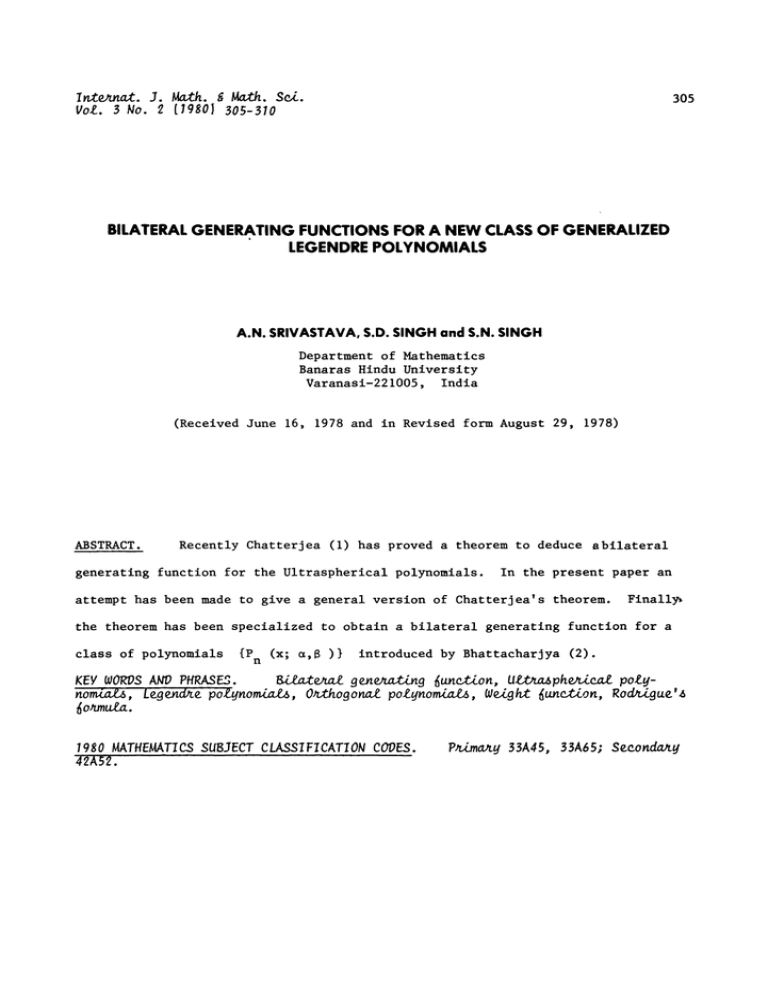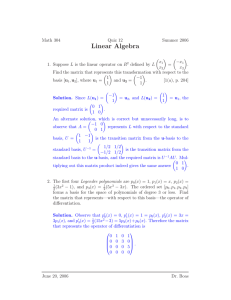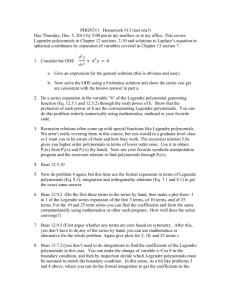BILATERAL M. GENERALIZED GENERATING FUNCTIONS FOR A NEW CLASS
advertisement

I ntnat. J. Mh.
Vol. 3 No. 2
(7980|
M. Si.
305
305-310
BILATERAL GENERATING FUNCTIONS FOR A NEW CLASS OF GENERALIZED
LEGENDRE POLYNOMIALS
A.N. SRIVASTAVA, S.D. $1NGH and S.N. SlNGH
Department of Mathematics
Banaras Hindu University
Varanasi-221005, India
(Received June 16, 1978 and in Revised form August 29, 1978)
ABSTRACT.
Recently Chatterjea (i) has proved a theorem to deduce a bilateral
generating function for the Ultraspherical polynomials.
In the present paper an
attempt has been made to give a general version of Chatterjea’s theorem.
Finally,
the theorem has been specialized to obtain a bilateral generating function for a
class of polynomials
{P
n
(x; u,B )}
introduced by Bhattacharjya (2).
Bilateral genng function, Ultaphrical polyKEY WORDS AND PHRASES.
Legendre polynomials, Orthogonal polynomials, Weight function, Rodrigue s
nom
formula.
1980 MATHEMATICS SUBJECT C LASSI FI CATI ON CODES.
42A52.
Primary 33A45, 33A65; Secondary
306
A. N. SRIVASTAVA, S. D. SINGH AND S. N. SINGH
I.
INTRODUCTION.
-
Using the following differential formula for the Ultraspherlcal polynomials
Pn
(x) due to Tricomi,
n
(x2- I +
n
Dn
(x2-1)
(I I)
Chatterjea (I) has recently obtained a bilateral generating function for the
Ultraspherical polynomials in the form of following theorem.
THEOREM
I.
If
am
F(x, t)
then
p
-21
x-t
F(--p
.
ty
p
tm PIm (x)
tr
r=o
b (y)
r
pl
r
(x)
(1.2)
where
b (y)
r
m=o
mr
a
m
m
y
and p
(l-2xt+t
2)I/2
A closer look at the above relation (1.2) suggests the following interesting
general version of Chatterjea’s theorem:
2.
Let F o
G
be used
to denote the composition F o
F(G(x)).
G(x)
In
terms of this notation, we state
THEOREM 2.
Suppose that there exist functions f, g, h and X and a
sequence of constants {c n} such that the sequence of functions
by the formula
{Qn }
is
generated
BILATERAL GENERATING FUNCTIONS FOR LEGENDRE POLYNOMIALS
where D
-
Cn
d/dx.
f
gn Qn
n
D h,
X
307
(2.1)
n= 0,1,2,
Define the generating function
(xt)
(2.2)
t
n--o
Then
fF( X gtz)
[x+t
f
n
k=o
c
n--o
n
(gt)
n
%0
X bn (z),
where
k
PROOF.
c
k
(n-k)
By Taylor’s theorem
fF(X,gtz)
e
]x+t
tD
(2.3)
fF (X, gtz).
To evaluate the right hand side of (2.3), we shall use as our starting point the
relations (2.1) and (2.2), and the series expansion for e tD
Thus
tD
tD
n
e
e
fF(X,gtz)
a (gtz) Qno x
f
n--o n
a
n n
tD
n
e
(tz) D h
L
n--o
n
..
(anlcn)
n=o m=o
"
m=o
f
c
n--o
where
bn" (z)
n
(gt)
n
f(x)
c
n
g(x)=
(x2-1) -1/2
X (x)=
z
x(x2-1)
X
n
bn
z
c(n-k)
n’. /(-i) n then Theorem 2 would correspond
APPLICATIONS:
Qno
ak
k=o
It is worthwhile to remark here that if we choose
(x2-1) -x
n+m
n+m
D
hlm’.
(anlcn) (gtln+m Cn+m f Qn+m
[
n=o
t
(x)
-1/2
Xlm’.
(z)
k
pX
n
(x)
h(x)--
(x2-1)
X and
to Chatterjea’s theorem.
Earlier, lattacharJya (2) introduced a new class of
generalized Legendre polynomials {P (x"
n
,
)} which
are orthogonal wlth the
308
A.N. SRIVASTAVA, S. D. SINGH AND S. N. SINGH
(6.6) and (6.8))"
2
are
The Rodrlgue’s formulae for these polynomials
) 12"
(i
(l_x2)
P2m (x-I/2
+I)/2
(-2m-( a-l)12
xm+(
,8
(.I_X)(
Dm
(i_x)m-(
8- )/2
)m
8- )/2
+1)/2
(2.4)
-m-( +3)/2
(2.5)
x--(
and
P2m+l (x-12
x,m+l+ /2
a,8
(l-x)
8- )/2
(+I)/2)m
)/2
Dm [ (l_x)m-(8
(-2m-(
Here we note that the sequences
{P2n (x-I/2
X
s-2n, 8) } and
P
2+l(X- I/2
s -2n, 8) } are amenable to a method of Theorem 2 for finding bilateral generating
;functions.
(x)
Let
(x;s-2n, 8)
P2n
-( s+l)/2
y
g(x)
--(l-x)
by
t
x-t
-I,
Y
(--X-)
X (x)ffi x-12 and
z
-t and
6
and
by
(x).
For simplicity of notation, set
y
(u-8)/2. Then (2.1) holds with f(x)
x (l-x)
P2n
(n)
Cn
(-n-(
-l)/2)n.
Upon
replacing
-y, we get
1- (x-t)
-x
_t)
I/2
(.
I- (x-t))
r=o
P2r (x-I/2)
-t
_.x
b
r
r
(r).
(_y),(2.6)
where
I
I/2
t
l-x
III=O
and
a
b
Now replacing
-1/2
x
r
[
(-y)
m
t
m
I--T) e2m
(x 1/2
(_y)m
#(m)
t=O
by s and t/(l-x) by
t
am
in
(r-m)
(2.6), we are led
(2 7)
to the following
bilateral generating function for gernerallzed even Legendre polynomials:
COROLLARY.
i:
If
F(x,t)
[.
----O
a
m
P2m
(x)
BILATERAL GENERATING FUNCTIONS FOR LEGENDRE POLYNOMIALS
309
then
[
l-(x2-1)t ]Y
F
(l+t)
i
x
(l_t
(x2_l)) 1/2
l+t
r--o
P2r(X)
where b
r
m+2)/2,
-I
(l-x)
g(x)
z
-y
by
r
(-y)
(-y) is given by (2.7).
In the same way, let
=
b
(x)
Qn
-8 )/2.
-1/2
X (x)
(x; m-2n, 8)
P2n+l
(x), and set
(l-x)
Then (2.1) holds with f(x)
and c
x
P2n+l
(-n-(+l)/2) n. Replacing
(n)
n
t by-t and.
and making the same substitution as before in (2.7), we are led to the
following bilateral generating function for generalized odd Legendre polynomials.
CCROL LARY
2
If
am P2m+l
F (x,t)
m--o
(x),
then
l-(x2-1)t] Y
F
(l-t)
(
__t_[__)
x
i-t (x
2- i)
1/2
1
.
(_t)r
P2r+l
where
a
c
r
m
[
(-y)
(r)
r=o
(x) c r (-y),
(_y)m
Y(m) (r-m)
m=o
8 in Corollary 1 and 2, we can obtain bilateral generating functions
Taking
for generalized Legendre polynomials due to Dutta and More (3).
Next, we note that (2),
(-i)
(x;o,o)
P2m
m
m: P2m
(x)
(-2m +" 1/2) m
(2.8)
and
(_)m
(x;o,o)
where P
2m
(x)
P2m
and
P2m+l
m.
P2m+l
(x)
(2.9)
(-2m- 1/2) m
(x) are
(2.8), (2.9) and the above
even
and odd Legendre polynomials
Therefore, by
two corollories we can obtain bilateral generating
functions for Legendre polynomials.
A. N. SRIVASTAVA, S. D. SINGH AND S. N. SINGH
310
Acknowledgements
The authors wish to express their thanks to the referee for his valuable
suggestions for the improvement of this paper.
REFERENCES
I.
CHATTERJEA, S.K.,A Bilateral generating Function for the Ultraspherlcal
Polynomlals,Paclflc J. Math. 29 (1969) 73-76.
2.
BHATTACHARJYA, M. ,On Some Generalisation of Legendre Polynomials,
Bull. Cal. Math. Soc. 66 (1974) 77-85.
3.
DUTTA, M. and MORE, K.L., A New Class of Generallsed Legendre Polynomials,
Mathematlca (Cluj) 7(30) (1965) 33-41.






